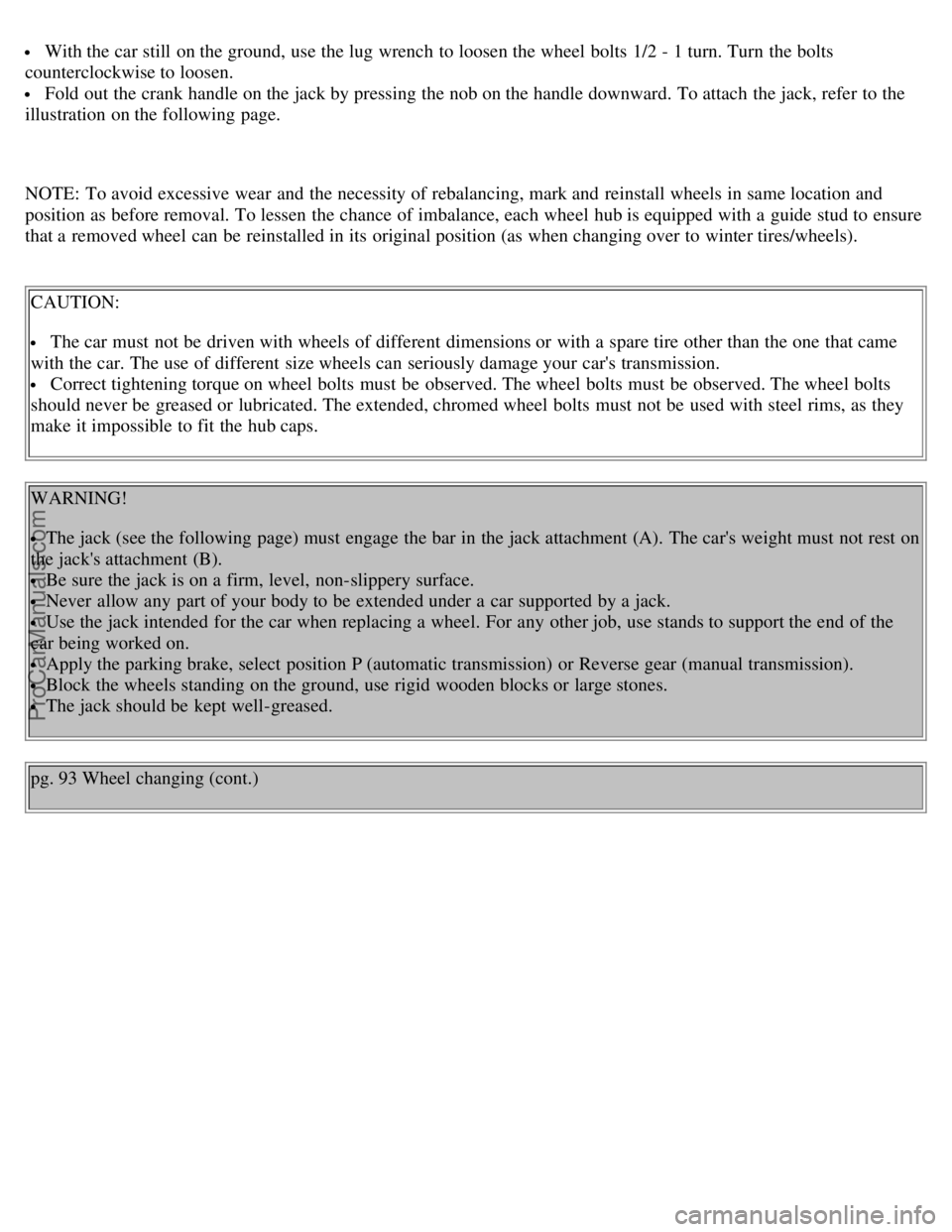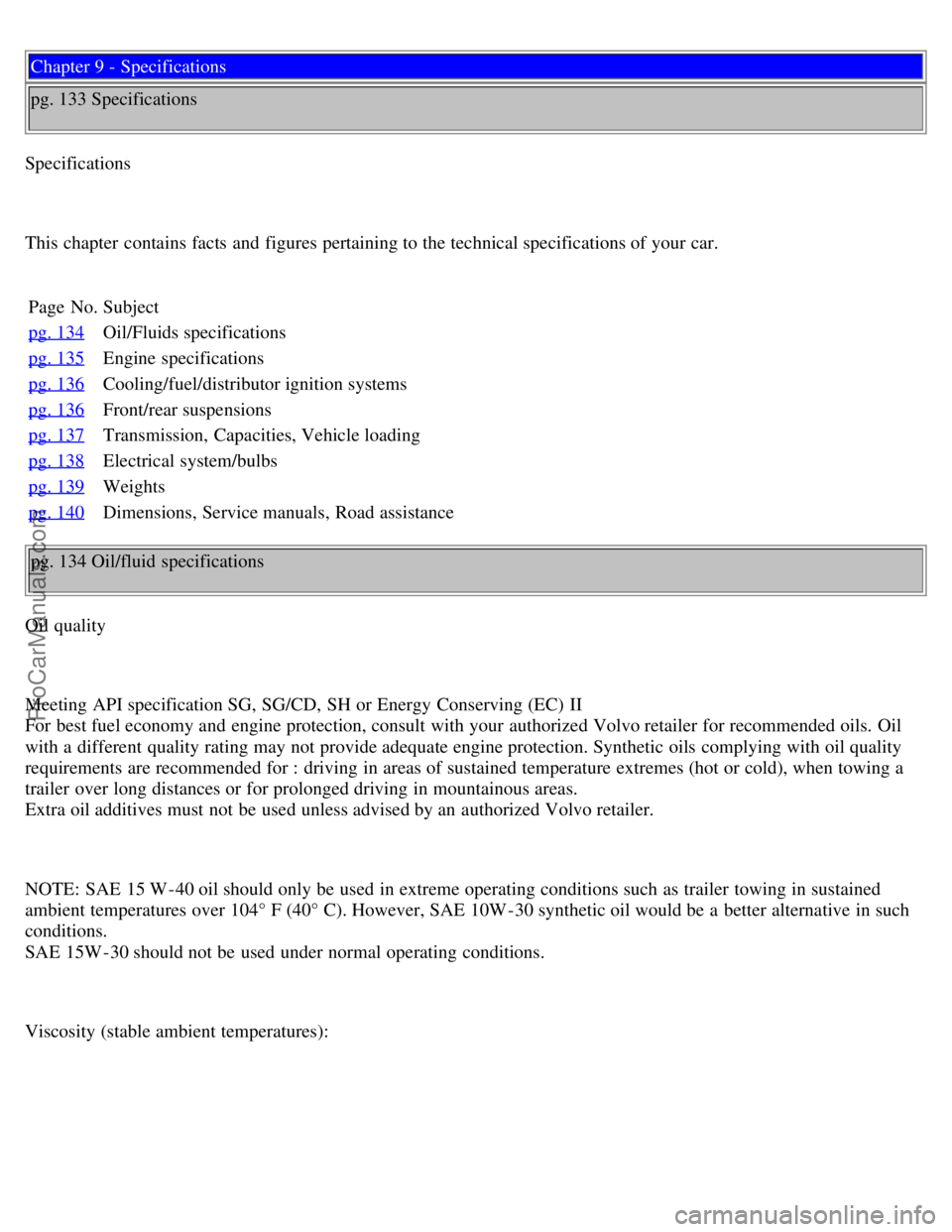weight VOLVO V70 1999 Owners Manual
[x] Cancel search | Manufacturer: VOLVO, Model Year: 1999, Model line: V70, Model: VOLVO V70 1999Pages: 61, PDF Size: 0.88 MB
Page 2 of 61

In production, Volvo has partly or completely phased out several chemicals including freons, lead chromates,
naphtanates, asbestos, mercury and cadmium; and reduced the amount of chemicals used in our plants 50% since 1991.
In use, Volvo was the first in the world to introduce into production a three-way catalytic converter with a Lambda
sond, now called oxygen sensor, in 1976. The current version of this highly efficient system reduces emissions of
harmful substances (CO, HC, NOx) from the exhaust pipe by approximately 95% and the search to eliminate the
remaining emissions continues. Volvo is the only automobile manufacturer to offer CFC-free retrofit kits for the air
conditioning system for all models back to the M/Y 1975 240. Advanced electronic engine controls, refined
purification systems and cleaner fuels are bringing us closer to our goal.
After Volvo cars and parts have fulfilled their use, recycling is the next critical step in completing the life cycle. The
metal content is about 75% of the total weight of the car, which makes the car among the most recycled industrial
products. In order to have efficient and well controlled recycling, many Volvo variants have printed dismantling
manuals indication the weight and material of individual components. For Volvo, all homogeneous plastic parts
weighing more than 1.7 oz. (50 grams)are marked with international symbols that indicate how the component is to be
sorted for recycling.
In addition to continuous environmental refinement of conventional gasoline-powered internal combustion engines,
Volvo is actively looking at advanced technology alternative-fuel vehicles.
When you drive a Volvo, you become our partner in the work to lessen the car's impact on the environment. To reduce
your vehicle's environmental impact, you can:
Maintain proper air pressure in your tires. Tests have shown decreased fuel economy with improperly inflated
tires Follow the recommended maintenance schedule
Drive at a constant speed
See an authorized Volvo retailer as soon as possible for inspection if the check engine (malfunction indicator)
lamp illuminates, or stays on after the vehicle has started
Properly dispose of any vehicle related waste such as used motor oil, used batteries, brake pads, etc.
When cleaning your car, use Volvo's own car care products, all of which have systematically been adapted to
the environment.
Contents
Table of Contents
Page No.
Chapter and Subject
pg. 1Chapter 1 - Occupant safety
pg. 16
Chapter 2 - Instruments and controls
pg. 41
Chapter 3 - Body and interior
pg. 65
Chapter 4 - Starting and driving
pg. 85
Chapter 5 - Wheels and tires
pg. 91
Chapter 6 - In case of emergency
pg. 109
Chapter 7 - Car care
pg. 115
Chapter 8 - Volvo Service
ProCarManuals.com
Page 4 of 61

Chapter 1 - Occupant safety
pg. 1 Occupant safety
Occupant safety
Despite our strongest recommendations, and your best intentions, not wearing a seat belt is like believing "It'll never
happen to me!". Volvo urges you and all adult occupants of your car to wear seat belts and ensure that children are
properly restrained, using an infant, car or booster seat determined by age, weight and height.
Fact: In every state and province, some type of child-restraint legislation has been passed. Additionally, most states
and provinces have already made it mandatory for occupants of a car to use seat belts.
So, urging you to "buckle up" is not just our recommendation - legislation in your state or province may mandate seat
belt usage. The few seconds it takes to buckle up may one day allow you to say, "It's a good thing I was wearing my
seat belt".
Chapter Contents
Page No.
Subject
pg. 2Seat belts
pg. 4
Volvo SRS
pg. 8
Side Impact Protection System - (SIPS) air bag
pg. 9
Child safety
pg. 14
Occupant safety
pg. 14
Reporting Safety Defects
pg. 2 Seat belts
Seat belts
Always fasten the seat belts before you drive or ride.
Two lights above the rear view mirror will be illuminated for 4-8 seconds after the starting (ignition) key is turned to
the driving position. A chime will sound at the same time if the driver has not fastened his seat belt. The rear seats are
provided with self -retracting inertia reel belts. The front seats are provided with single roller belts with tensioners.
ProCarManuals.com
Page 28 of 61

With the car still on the ground, use the lug wrench to loosen the wheel bolts 1/2 - 1 turn. Turn the bolts
counterclockwise to loosen.
Fold out the crank handle on the jack by pressing the nob on the handle downward. To attach the jack, refer to the
illustration on the following page.
NOTE: To avoid excessive wear and the necessity of rebalancing, mark and reinstall wheels in same location and
position as before removal. To lessen the chance of imbalance, each wheel hub is equipped with a guide stud to ensure
that a removed wheel can be reinstalled in its original position (as when changing over to winter tires/wheels).
CAUTION:
The car must not be driven with wheels of different dimensions or with a spare tire other than the one that came
with the car. The use of different size wheels can seriously damage your car's transmission.
Correct tightening torque on wheel bolts must be observed. The wheel bolts must be observed. The wheel bolts
should never be greased or lubricated. The extended, chromed wheel bolts must not be used with steel rims, as they
make it impossible to fit the hub caps.
WARNING!
The jack (see the following page) must engage the bar in the jack attachment (A). The car's weight must not rest on
the jack's attachment (B).
Be sure the jack is on a firm, level, non-slippery surface.
Never allow any part of your body to be extended under a car supported by a jack.
Use the jack intended for the car when replacing a wheel. For any other job, use stands to support the end of the
car being worked on.
Apply the parking brake, select position P (automatic transmission) or Reverse gear (manual transmission).
Block the wheels standing on the ground, use rigid wooden blocks or large stones.
The jack should be kept well-greased.
pg. 93 Wheel changing (cont.)
ProCarManuals.com
Page 29 of 61

Jack attachment - front wheel drive models
Attaching the jack
There is a jack attachment located in the center on each side of the car. Position the jack on the bar in the attachment
(A in illustration above) and crank while simultaneously guiding the base of the jack to the ground. The base of the
jack must be flat on a level, firm, non-slippery surface. Before raising the car check that the jack is still correctly
positioned in the attachment .Raise the vehicle until both wheels on the side of the car where the jack is attached are
lifted off the ground. Unscrew the wheel bolts completely and carefully remove the wheel so as not to damage the
thread on the studs.
Additional rear jack attachment on All Wheel Drive cars
Attaching the jack on cars with All Wheel Drive (AWD)
Due to the greater weight of AWD-equipped cars, these models have an additional jack attachment point located
directly in front of the rear axle. When using a workshop floor jack, make sure that the correct attachment is used and
that the jack does not damage the fuel tank.
The attachment is, of course, also intended for use with the standard jack supplied with the car.
ProCarManuals.com
Page 43 of 61

Chapter 9 - Specifications
pg. 133 Specifications
Specifications
This chapter contains facts and figures pertaining to the technical specifications of your car. Page No. Subject
pg. 134
Oil/Fluids specifications
pg. 135
Engine specifications
pg. 136
Cooling/fuel/distributor ignition systems
pg. 136
Front/rear suspensions
pg. 137
Transmission, Capacities, Vehicle loading
pg. 138
Electrical system/bulbs
pg. 139
Weights
pg. 140
Dimensions, Service manuals, Road assistance
pg. 134 Oil/fluid specifications
Oil quality
Meeting API specification SG, SG/CD, SH or Energy Conserving (EC) II
For best fuel economy and engine protection, consult with your authorized Volvo retailer for recommended oils. Oil
with a different quality rating may not provide adequate engine protection. Synthetic oils complying with oil quality
requirements are recommended for : driving in areas of sustained temperature extremes (hot or cold), when towing a
trailer over long distances or for prolonged driving in mountainous areas.
Extra oil additives must not be used unless advised by an authorized Volvo retailer.
NOTE: SAE 15 W -40 oil should only be used in extreme operating conditions such as trailer towing in sustained
ambient temperatures over 104° F (40° C). However, SAE 10W -30 synthetic oil would be a better alternative in such
conditions.
SAE 15W -30 should not be used under normal operating conditions.
Viscosity (stable ambient temperatures):
ProCarManuals.com
Page 59 of 61

T
Tachometer.................................18Tailgate (opening/locking).................47..lock button..............................47Tailgate wiper/washer......................26Temperature gauge..........................18Temporary spare tire.......................94Three -way catalytic converter..............79Tire pressure..............................88Tires .....................................86Tires - changing...........................92Towing..................................76,77Towing a trailer...........................84Traction Control System(TRACS)....19,21,25,81Trailer towing.............................84Trip computer.....................25,28,29,30Trip odometer..............................18Trunk - opening/locking....................47Trunk light................................55Turn signals............................19,22
U
Uniform tire quality grading...............89Upholstery - cleaning.....................114
V
Vanity mirrors.............................51Vehicle Identification Number (VIN).......116Vehicle loading...........................137Volvo On Call.............................140
W
Warning flashers...........................25Warning lights..........................20,21Warranty..................................117Washer fluid level.........................19Washer fluid reservoir....................129Washing...................................112Waxing....................................113Weights...................................139Wheel changing..........................92,93Wheels and tires...........................86Windows - electrically-operated............40Windshield washer nozzles.................129Windshield wiper blades - replacing.......106Winter driving.............................82
Inside Back Cover
WARNING!
Detergents and solvents
Do not use gasoline containing lead or benzene as a detergent or solvent. Both lead and benzene
are toxic and may be hazardous to your health.
Installation of optional equipment/use of mobile telephones
Incorrectly installed optional equipment, alarm systems or the use of mobile telephones which
ProCarManuals.com